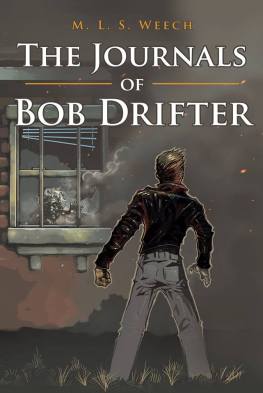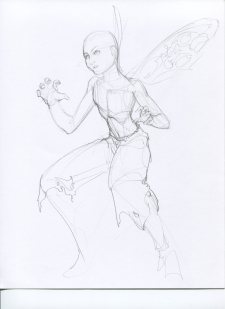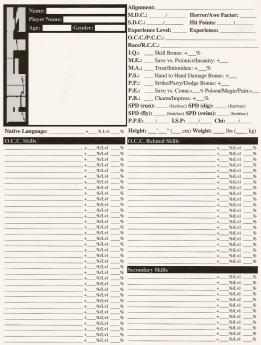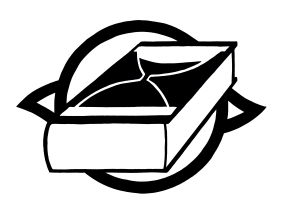 Character development is a fluid process for me. I consistently try new things and keep what I feel worked and get rid of what I don’t like. Sometimes I bring those things I don’t like back because as much as I don’t like them, they help me create more realistic, sympathetic characters.
Character development is a fluid process for me. I consistently try new things and keep what I feel worked and get rid of what I don’t like. Sometimes I bring those things I don’t like back because as much as I don’t like them, they help me create more realistic, sympathetic characters.
I put a lot of thought into how to present this because of how fluid my process is. I thought about taking you through how I evolved and what I tried. I can do that if anyone is interested, but what I think anyone would use this for is to put what I know I’m going to do when I start writing my eight book (Sojourn is a short story and Elele is already developed).
 Quintessential Editor covered some ground with his blog about using dice to create characters. This comes in handy mostly because of the character sheets for me. I did this a few times. It worked, but I thought it was too time consuming, so I dropped the sheets. Now I’m brining them back because some books have WAY too much for me to track. I have word processing character sheets, and I may adapt those, but I need something that helps me track my characters, particularly physical attributes.
Quintessential Editor covered some ground with his blog about using dice to create characters. This comes in handy mostly because of the character sheets for me. I did this a few times. It worked, but I thought it was too time consuming, so I dropped the sheets. Now I’m brining them back because some books have WAY too much for me to track. I have word processing character sheets, and I may adapt those, but I need something that helps me track my characters, particularly physical attributes.
I also took full advantage of Brandon Sanderson’s online lecture about Character Creation. That helped me mostly as it came to plotting. (Note: Today, I’m talking about development. That way, I can talk about plotting later.) But it does give me a snapshot, and it helped me streamline (in my case too effectively) my character sheets.
My character sheets start as simple pages in a word processing document. They get larger as I start plotting the character.
A note on archetypes. I outlined Caught using archetypes. While I want to know the role my characters play in the book, what I found this ended up doing was make my characters too cookie cutter. They fit their role in the plot, but it made them plot devices and not characters. I think what I’ll do next time is add the archetypes to the character sheet, though this still scares me. (NOTE: As I publish this, I’ve again decided against it.) I’m a very literal, linear thinker, and I don’t want to force my characters in a direction they wouldn’t go just so they fit some standard archetype.
 Where my ideas come from: I teach my students about this concept where a writer has an idea for a story. I got it from one of my sources we used to develop the course, Telling True Stories. They call it the glimmer moment. I exist in a constant state of glimmer infinity. I constantly have flashes of imagination or insight that I think would be amazing. I jot them down or commit them to memory (let the debate on memory begin here). When enough of those ideas arrive to formulate one consistent narrative, I know I have a story. The idea for Caught came to me when my mom told me about a nightmare she had had. (Am I a bad son?)
Where my ideas come from: I teach my students about this concept where a writer has an idea for a story. I got it from one of my sources we used to develop the course, Telling True Stories. They call it the glimmer moment. I exist in a constant state of glimmer infinity. I constantly have flashes of imagination or insight that I think would be amazing. I jot them down or commit them to memory (let the debate on memory begin here). When enough of those ideas arrive to formulate one consistent narrative, I know I have a story. The idea for Caught came to me when my mom told me about a nightmare she had had. (Am I a bad son?)
I mention that because sometimes the main character develops clearly in my mind. Sometimes they don’t. What I mean is I have a sense for the emotional description of the character, but not the physical one. When I see the character clearly in my mind, I don’t fight it. When it doesn’t matter, I let chance determine those characteristics. For Perception of War, the flip of a coin determined the gender of my character. A four-sided die determined his ethnicity and color. I’ll probably post a blog about this one day, but I think characters are people.
![]() There are several fantastic stories out there where race, religion, and gender are arcs. When they aren’t I feel silly developing a white male character simply because I’m a white male. Sal, the main character in Caught is a protector and a Soldier. He was always a man in my imagination, but I’ll tell you frankly the majority of the service members I respect most happen to be women. It’s not a knock on one over the other, just a point I’m trying to work to. He was a man, because of the dynamic I wanted to create with a few other characters. He was white because my four-sided die said so. He’s from Philly because that’s where my finger landed on a map. When these traits matter, writers should take great care. They always have significance though because they’re parts of what make a person who he (Sal) is. None of those characteristics affected the plot, so I let chance decide because it’s fast, and in my mind, it’s the best way I have so far to make sure the diversity in my books comes anywhere near the diversity of life.
There are several fantastic stories out there where race, religion, and gender are arcs. When they aren’t I feel silly developing a white male character simply because I’m a white male. Sal, the main character in Caught is a protector and a Soldier. He was always a man in my imagination, but I’ll tell you frankly the majority of the service members I respect most happen to be women. It’s not a knock on one over the other, just a point I’m trying to work to. He was a man, because of the dynamic I wanted to create with a few other characters. He was white because my four-sided die said so. He’s from Philly because that’s where my finger landed on a map. When these traits matter, writers should take great care. They always have significance though because they’re parts of what make a person who he (Sal) is. None of those characteristics affected the plot, so I let chance decide because it’s fast, and in my mind, it’s the best way I have so far to make sure the diversity in my books comes anywhere near the diversity of life.
That brings me to character sheets. Like I said, I’m going to bring more elements in, but here’s Bob’s character sheet.
START
 Bob Drifter : Robert Drifter
Bob Drifter : Robert Drifter
6’3”
230 lbs
Light brown hair
Brown eyes.
Bob’s exactly what I named him. He’s a drifter. In personality as well as occupation. He’s accepted who and what he is, for now at least, because it’s all he’s known. He’s kind and takes it upon himself to be more of a guide than a conduit. Others in his field don’t take such measures, but a part of who Bob is demands a certain courtesy. He doesn’t remember anything at all about his life before his work. A part of him is curious, but, given his nature, he accepts things without much argument. Things are. Part of this stems from his belief that change isn’t possible for him.
END
Now take a look at Elele’s. This is her character sheet from Sojourn. Please know I’ve absolutely deleted a few spoilers, and that may cause some confusion, but I’d like people to read the book and be entertained by some of the twists. Note the differences between her character sheet and Bob’s:
START

Elele’Therios
(The trouble with Sefaram is that they all look essentially the same. Hair is a thing. But they’re very hard to tell apart unless you look at their Faline. These fractal patterns are the way Sefaram see one another. Where humans look at skin color facial shapes (shapes are a thing for Sefaram too), Sefaram rely most on the inner-most ring of the faline.)
Age: 22
Occupation: Mathematician
Hobby 1) Travel
Hobby 2) mathmatics.
Height: 60.8 inches – 5’1”
Weight: 161 pounds
Build: Sleek. (She’s twiggy even by Seferam standards.)
Skin Tone: Black (All Sefaram are)
Voice Quality: Analytic. Snappy. Quick. Clips words.
Hair Color: Black (All Sefaram with hair have this)
Hair Length: Mid-shoulder
Hair Style: Rolled and braided. What would you call cornrowed hair that is braided into multiple braids…then braided again? (I don’t speak hair). (NOTE: I did some research and talked to a friend. The most accurate term I found was braided weave)
Eye Color: Black (All Sefaram)
Eye Shape: large ovals longer than tall. (deer eyes) (All Sefaram)
Face Shape: Round.
Freckles: None (Sefaram have none)
Moles: None (See above)
Scars: None as of Sojourn. (SPOILER DELETED INFORMATION)
Faline: Outter pattern (FAMILY IDENTIFIER): Four tear-drop-shaped loops in which the points meet in the middle. Inner Pattern (INDIVIDUAL IDENTIFIER): A pattern resembling a seven-pedaled flower blossom. (NOTE: Faline are ultraviolet patterns on the mid-section of each Seferam. Think of them as luminescent tribal tattoos that follow fractal patterns).
Clothing: (All Sefaram leave their faline exposed. Men usually go bare chested. Elele wears what are considered prudish clothes. No style or fashion (especially since the bad guy’s arrival). She were’s a simple outfit that ties around the neck. It covers her breasts. Cloth covers her sides and becomes a mid-calf length dress. It’s always a simple color with no ultraviolet patterning (a common fashion trend these days). She wears simple leather shoes. (SPOILER INFO DELETED)
Jewelry: None. Sefaram don’t wear it. Their bio-electro-magnetic power plays hell with metal.
faline: For Seferam, they’re an emotional cue. They pulse in different ways the way humans blush or flush.
END
You’ll see a lot of elements from the above-mentioned Sanderson Lecture there. Like I said. I can promise you that second hobby gave Elele a dimension I never really expected. Little things like that help me get deeper into her character. I didn’t realize math was going to be such a huge part of her character until I gave her that hobby. It then became her occupation. It’s now one of her key assets to how she sees the world and progresses in her plot.
Not all of this became cannon. (Note the picture, she looks very different now that she’s all fleshed out) I left in some of my self-notes. They’re my musings, motivations or research sites for me to get a better feel. I did delete a bunch of my self notes because they were far too spolierific for me to include.
 So my next evolution will blend all of these to help me develop a character in terms of physical attributes, motivations, archetype, and plots. Where Corey uses his D & D sheets, I was always a Rifts man myself. I’ll let those character sheets provide the physical attributes. I’ll let the Sanderson lecture round the character out. Then I’ll let them work together to make the character more realistic. Then I’ll let the plotting provide the finishing touches.
So my next evolution will blend all of these to help me develop a character in terms of physical attributes, motivations, archetype, and plots. Where Corey uses his D & D sheets, I was always a Rifts man myself. I’ll let those character sheets provide the physical attributes. I’ll let the Sanderson lecture round the character out. Then I’ll let them work together to make the character more realistic. Then I’ll let the plotting provide the finishing touches.
I feel this needs a summary:
1) Identify character. Leave what speaks to you alone and let chance determine all other physical attributes. For Elele, I knew she was female, and I knew what species she was. I also knew what culture I would borrow from most heavily for that species.
2) Name the character. (I’m all over the place here. I do everything from a quick study of names, to popular names of other cultures. Sometimes I look for what a name means in a language I best feel fits the culture of the character. When all else fails, I use a random name generator. For Elele, I realized I liked the idea of palindrome names. There’s a mathematical significance to that (and also one of the other species in the book) that I felt was appropriate.
3) Fill in physical attributes. This includes race, species and other aspects of the character’s background.
4) Establish occupation, hobbies and goals. (this is where some plotting comes in).
 5) Begin plotting. This is the most critical step. Every character is the main character in THAT character’s mind. So I plot as if this character is in her own story. I’m not married to this plotting or outline. Elele’s actual arc has some significant differences from the outline, but not who she is or what she does.
5) Begin plotting. This is the most critical step. Every character is the main character in THAT character’s mind. So I plot as if this character is in her own story. I’m not married to this plotting or outline. Elele’s actual arc has some significant differences from the outline, but not who she is or what she does.
This gives me the freedom to get to know my characters in my own natural way. I’m a discovery writer at heart, and I need some room for that to work. What I don’t ever do is start plotting before I get a sense for the core of my character. When I outline one way, then realize my character wouldn’t do that, I don ’t fight it. Early on in Elele’s arc in Images of Truth, Elele was supposed to act and work in one way. Then I realized she wouldn’t handle that situation in the outlined manner. Her decision was more heroic, and led to better conflict and emotional payoff.
(NOTE: I’m talking about her role in Images of Truth, not Sojourn. Sojourn is a prequel to Images.)
Every character has a core just like every person. I find that core by gifting them traits. I take something from a character I love. I take something from someone I love. I take something from someone I don’t like very much. Then I take something from myself. I blend them together and it makes a new character I understand very well.
 Let’s look at Bob: His part-time job and love of reading came from me. His drive to understand came from my mom. His love of quoting things came from Beast of the X-Men. I won’t tell you where his frustrating ability to mope comes from, because I’m not trying to dime out people I’m not actually a big fan of. (Note, I said people I don’t like very much. Me not liking a person in no way makes them bad or even unlikable. I feel naming said individual would borderline on slanderous.)
Let’s look at Bob: His part-time job and love of reading came from me. His drive to understand came from my mom. His love of quoting things came from Beast of the X-Men. I won’t tell you where his frustrating ability to mope comes from, because I’m not trying to dime out people I’m not actually a big fan of. (Note, I said people I don’t like very much. Me not liking a person in no way makes them bad or even unlikable. I feel naming said individual would borderline on slanderous.)
Doing that is what gives me a picture for how they would handle situations. We writers need to remember though that the horrible things we put our characters through is going to change them. If it doesn’t, it won’t feel realistic. I get a baseline from this, then let their experiences shape how they’ll handle future decisions.
I hope that helps. Honestly, it’s just the way I do it. How do you do it? Was this helpful? Any tricks or resources you like? Feel free to say as much in the comments below.
Thanks for reading
Matt
